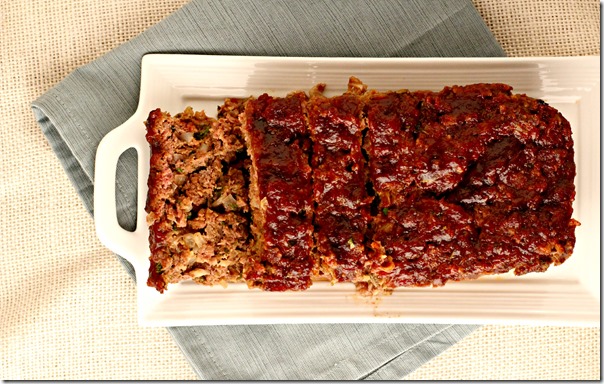Meatloaf Recipe With Ketchup
source (google.com.pk)As if to turn on a dime, the little person I cook for and eat with most often went from proclaiming that oysters were her favorite food to announcing that her favorite food was in fact a hamburger. I knew this would happen.
So, in an effort to temper meat consumption, but still occasionally provide her with what she says she loves, we make a big stink out of it: clapping out our own patties, simmering sweet onions, and now, making our own ketchup.
If you want a decent bottle of ketchup from the store, it's possible. There are numerous artisanal food producers making small batch ketchups. You can even find a bottle of Heinz made from organic tomatoes and no high fructose corn syrup. But making it at home isn't difficult at all, especially this time of year when funky tomatoes are abundant (and often discounted) at my local farmers' market, it seems the proper thing to do to get in the kitchen and simmer down a couple of pounds of tomatoes into our own homemade ketchup.
Your average ketchup has tomatoes, vinegar, a sweetener, plus various seasonings and spices. In commercial ketchup, the sweetener is usually sugar or high-fructose corn syrup. The seasonings can vary from a simple lineup of salt and pepper, to a longer list including onions, allspice, cloves, cinnamon, garlic, some heat from cayenne or other ground peppers, and even celery. So clearly there's a lot to work with there, nothing esoteric ingredients, no crazy equipment.
I recently met the amazing Alana Chernila, author of The Homemade Pantry, a wonderful book about making your own pantry ingredients. I asked her about ketchup and she waxed poetic. To Alana — and many of us — a good french fry is really just a vehicle for condiments like mayonnaise, spicy ketchup, or malt vinegar. "The search for my own perfect homemade ketchup was all about pumping up what I love about ketchup (just the right blend of spice, tang, and real tomato flavor) and getting rid of what I don't love (all that sweet high-fructose corn syrup)," Alana said. I couldn't agree more.
For my recipe, I take the middle road: I sweeten it with brown sugar with a dash of extra molasses for depth, add a few spices from the above list based on whatever is in the pantry, and most recently I started quietly adding a few dashes of fish sauce, a trick I learned from my new friend Peter Barret. Many recipes call for a food mill, but it's just as good made in a blender and a sieve.
The simple formula is simmer some tomatoes with garlic and/or onion, add vinegar and any of the spices you want. Blend it, strain it, then stir in the sweetener (honey? maple? go for it!) and simmer more. Chill. Ketchup. It's that easy. Who knows, you and some other people I know may even want to start putting it on oysters...
Homemade Ketchup
Makes about 1 pint
1 tablespoon olive oil
3 garlic cloves, chopped
1/2 yellow onion, chopped
4 pounds ripe beefsteak tomatoes, cored and chopped (or 4 pounds red cherry tomatoes, halved; or three 14.5-ounce cans tomatoes, drained)
1/2 cup cider vinegar (or white or red wine vinegar)
2 teaspoons salt
1 tablespoon fish sauce (optional)
1 1/2 teaspoons ground black pepper
1/4 teaspoon ground allspice
1/4 teaspoon ground cayenne pepper
1/4 teaspoon ground ginger
1/2 cup packed dark brown sugar
1 tablespoon molasses
Heat the olive oil in a wide heavy-bottomed non-reactive pan over medium heat. Add the onion and cook, stirring occasionally, until translucent, about 3 minutes. Add the garlic and cook for about one minute, stirring constantly. Add the tomatoes, vinegar, salt, fish sauce, black pepper, allspice, cayenne, and ginger and cook until the tomato pieces fall apart, about 20 minutes.
Working in batches, purèe in a blender until smooth and strain through a fine-mesh sieve. Stir in the brown sugar and molasses, return the mixture to the stove and cook again over medium heat, stirring often, until it thickens a bit more, between 15 and 30 additional minutes (depending on the type of tomatoes used.) Taste for seasoning.
Let the ketchup cool to room temperature, where it will thicken a bit more, then transfer it to jars with tight-fitting lids. Will keep refrigerated for up to 2 weeks. Can also be canned for longer stor
Meatloaf Recipe With Ketchup Meatloaf Recipe Jamie Oliver with Oatmeal Rachael Ray Paula Deen Bacon with Oats Filipino Style Easy Best with Gravy Photos

Meatloaf Recipe With Ketchup Meatloaf Recipe Jamie Oliver with Oatmeal Rachael Ray Paula Deen Bacon with Oats Filipino Style Easy Best with Gravy Photos

Meatloaf Recipe With Ketchup Meatloaf Recipe Jamie Oliver with Oatmeal Rachael Ray Paula Deen Bacon with Oats Filipino Style Easy Best with Gravy Photos

Meatloaf Recipe With Ketchup Meatloaf Recipe Jamie Oliver with Oatmeal Rachael Ray Paula Deen Bacon with Oats Filipino Style Easy Best with Gravy Photos

Meatloaf Recipe With Ketchup Meatloaf Recipe Jamie Oliver with Oatmeal Rachael Ray Paula Deen Bacon with Oats Filipino Style Easy Best with Gravy Photos

Meatloaf Recipe With Ketchup Meatloaf Recipe Jamie Oliver with Oatmeal Rachael Ray Paula Deen Bacon with Oats Filipino Style Easy Best with Gravy Photos

Meatloaf Recipe With Ketchup Meatloaf Recipe Jamie Oliver with Oatmeal Rachael Ray Paula Deen Bacon with Oats Filipino Style Easy Best with Gravy Photos

Meatloaf Recipe With Ketchup Meatloaf Recipe Jamie Oliver with Oatmeal Rachael Ray Paula Deen Bacon with Oats Filipino Style Easy Best with Gravy Photos

Meatloaf Recipe With Ketchup Meatloaf Recipe Jamie Oliver with Oatmeal Rachael Ray Paula Deen Bacon with Oats Filipino Style Easy Best with Gravy Photos

Meatloaf Recipe With Ketchup Meatloaf Recipe Jamie Oliver with Oatmeal Rachael Ray Paula Deen Bacon with Oats Filipino Style Easy Best with Gravy Photos

No comments:
Post a Comment